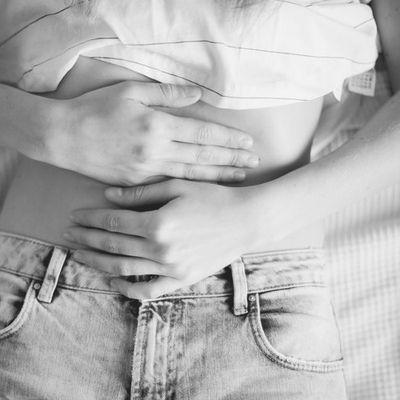
Everything You Need To Know About Ovulation Cramps
What exactly are ovulation cramps?
The word mittelschmerz, despite being fun to say, is actually derived from the German for ‘middle’ and ‘pain’ – this, rather obviously, is because the abdominal pain women experience from ovulating comes in the middle of your menstrual cycle (around 14 days before your period, says NHS.uk).
Mittelschmerz occurs when the follicle – a tiny sac in the ovary that contains an egg – ruptures and releases that egg. As it happens during ovulation, some women experience it monthly, while others might only feel it sporadically. The pain can also vary from person to person, with the discomfort ranging from an uncomfortable pinch or twinge that lasts mere minutes to severe cramping that can last for hours.
What causes them?
Just like with dysmenorrhea (extreme period pain), health experts still aren’t sure exactly what causes mittelschmerz. But there are theories as to what could trigger such pain – according to the Mayo Clinic, it could be due to the follicle growth stretching the surface of your ovary just before the egg is released, while another hypothesises that the blood or fluid released from the ruptured follicle irritates the lining of your abdomen, leading to discomfort.
Are they normal?
Yes. The Mayo Clinic advice that Mittelschmerz rarely needs medical intervention. It’s important to note, however, that mittelschmerz will only occur in the middle of your menstrual cycle – any other pain at any other point in your cycle isn’t ovulation cramps. Instead, it could simply be normal menstrual cramping if it happens during your period or could be the result of other abdominal or pelvic problem such as appendicitis, ectopic pregnancy, or endometriosis. For any pain that lasts longer than two days and/or is severe, it’s important you visit your doctor.
What do they feel like?
Ovulation cramps feels a lot like period cramps, only the pain will come from either the right or left side of your body, depending on which ovary released the egg. Some women might also feel it in their lower back and may even find that they bleed a little – but according to the NHS, that’s totally normal.
Can they be treated?
If the pain is severe, the NHS recommends easing the discomfort by taking an over-the-counter painkiller such as paracetamol, or having a long soak in a hot bath. Non-steroidal anti-inflammatory drugs (NSAIDs) like ibuprofen can also help, but shouldn’t be taken if you’re trying to get pregnant as they can interfere with ovulation. In fact, if you are trying to get pregnant, ovulation pain can be something of an advantage – if you feel the tell-tale pain of ovulation cramps, you’ll know you’re ovulating and are probably fertile.
And as health writer Jan Sheehan points out, consistent and bothersome mid-cycle pain like this can also be controlled with hormonal contraception such as birth control pills or patches. These work as they prevent ovulation – and without ovulation, you can’t experience the pain.
DISCLAIMER: We endeavour to always credit the correct original source of every image we use. If you think a credit may be incorrect, please contact us at info@sheerluxe.com.